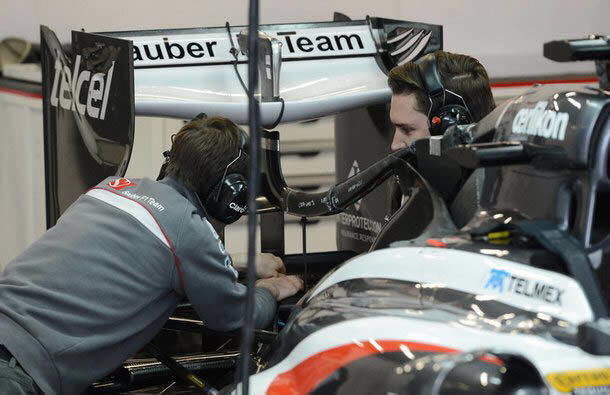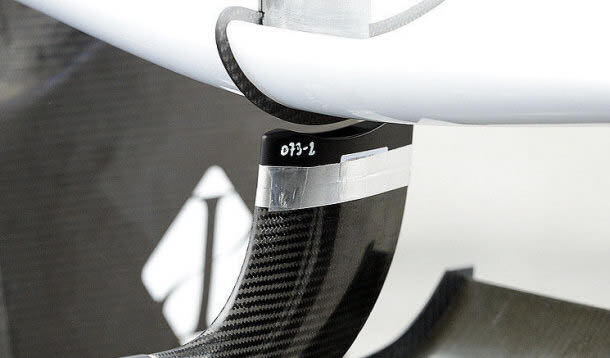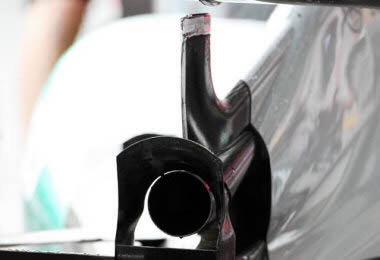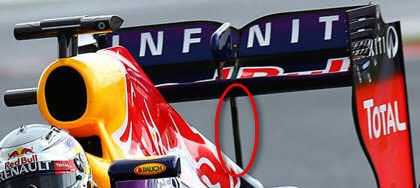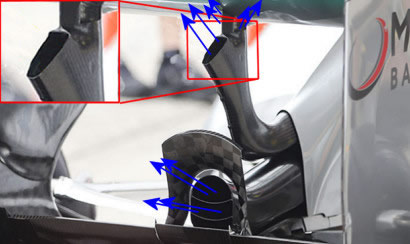Passive Double Drag Reduction System -
Passive Drag Reduction Device
Originally Mercedes system, based on exposing holes in the rear wing endplates when the DRS is deployed (Double DRS - DDRS) are outlawed for 2013, after Formula 1 teams agreed to a change of rules that will outlaw the concept for next year, via wording to prevent any secondary use of the DRS opening. This technology was pioneered by Mercedes at the start of 2012, when they linked the DRS with the front wing, to reduce the downforce from that to help boost speed on the straights and balance the car in the corners.
Mercedes led the way at the start of the 2012 season and this helped to provide a straight line speed boost.
Following discussions at F1 rules think-tank, the Technical Working Group, sources have revealed that a majority of teams agreed for a change in regulations that will ensure they cannot incorporate Double DRS into their cars for 2013.
Although Mercedes did not support the change in rules, because it had made such a headstart in the area, it could not stop the ban going through as it only needed a majority of teams to agree.
It is understood the changes to the rules will be made official by the FIA's World Motor Sport Council for year 2013 Technical regulations.
At the middle of the season 2012, Lotus tested a prototype of ‘passive drag reduction device’ fitted to the cars rear wing. Most people in the paddock and around are still calling it DDRS (Double DRS), but its not part of the DRS system. Its aim is to reduce drag on the straight for more top speed, and there is absolutely no connection with DRS or by FIA rules allowed moveable aero device.
Then, we have seen Mercedes test a similar device on their car at Spa 2012, with other teams rumored to have a system ready to test. The gain of the system is small, but anything that improves aero efficiency will be useful, whether to allow a higher top speed for a given downforce level, or vice versa, a gain in downforce level for a given top speed.
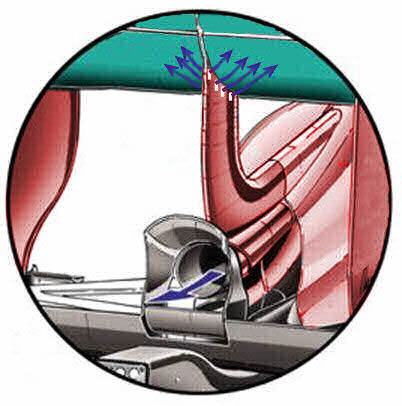 Unlike Mercedes DDRS, whose system stalls the front wing to balance the aero when the DRS rear wing is used in qualifying (and the race), the Lotus system is passive and not linked to an external switch (movable rear wing flap used for DRS). Instead the system uses increasing airspeed to send more flow to slots under the wing to stall the airflow in the middle part of the wing and in this way, by blowing the underside of the rear wing's main plane reducing drag passively above a certain speed threshold. This helps to stall the whole upper element giving your car the significant drag reduction. Sauber designer Matt Morris said the innovation is worth between "a few hundredths to a tenth of a second per lap, and a tenth can make a huge difference when the cars are so closely matched."
Unlike Mercedes DDRS, whose system stalls the front wing to balance the aero when the DRS rear wing is used in qualifying (and the race), the Lotus system is passive and not linked to an external switch (movable rear wing flap used for DRS). Instead the system uses increasing airspeed to send more flow to slots under the wing to stall the airflow in the middle part of the wing and in this way, by blowing the underside of the rear wing's main plane reducing drag passively above a certain speed threshold. This helps to stall the whole upper element giving your car the significant drag reduction. Sauber designer Matt Morris said the innovation is worth between "a few hundredths to a tenth of a second per lap, and a tenth can make a huge difference when the cars are so closely matched."
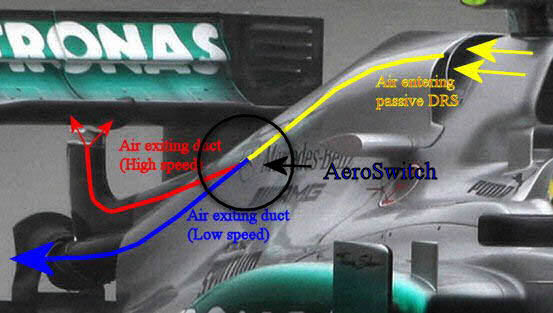
Air is entering trough two roll hoop inlets clearly visible either side of, and slightly behind the engine air inlet and duct work exiting the engine cover between the main plane and beam wings. Having the system passive means that the Lotus device can be used to stall the wing above a certain speed on every lap, meaning the small speed advantage is available on every straight and fast corner. With the system being tuned to airspeed, the wing can be designed to stall at speeds high enough to allow fast corners to be taken with the rear wing stalled. At these speeds the diffuser provides enough downforce for cornering and the rear wing is not required for aerodynamic load. Typically teams will want this stalling to occur at speeds of over 250kmh.
The implementation of the passive double DRS remains far from a no-brainer, especially after both Mercedes and Lotus encountered difficulties in gaining confidence with the prototype systems tested during 2012. System is fraught with difficulties, as the threshold speed at which the stalling should occur may vary from track to track and even throughout a race. And a sudden loss of downforce at high speed while cornering could cause a serious crash. Lotus and Mercedes both found out that due to air pressure characteristics surrounding an F1 car, the speed at which the passive DRS switched off to re-engage the rear wing was not always the same as that where it switched on. So, the biggest problem is in getting the device to switch on and switch off at the correct speed. It's also very tricky to have a system that's reliable, that withstands turbulent air of following another car without being triggered at moments that would be embarrassing, and to make it a positive gain on balance over the weekend. If this all sounds immensely complicated, that's because it is.
This meant that the trigger point had to be adjusted even higher to ensure that there was no risk of drivers not having rear downforce for corners immediately after long straights. Where it engages and where it re-engages are often not necessarily the same speed - as it can have some lag. The performance gain is there, but it is not huge. It's not like McLaren's F-duct was. It is something that is nice to have, but it is not going to be a game changer in terms of competitiveness.
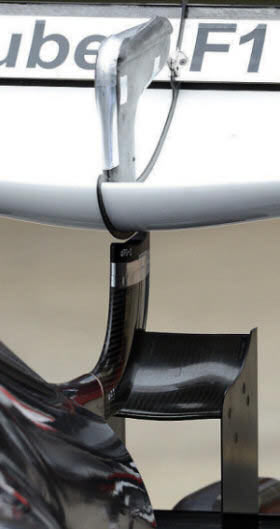 Despite Lotus and Mercedes struggling to set the 'aero switch' to deactivate and activates at the same speed, Lotus technical director James Allison is confident that the concept will earn its place on the 2013 car during pre-season testing. It was not present on the launch car.
Despite Lotus and Mercedes struggling to set the 'aero switch' to deactivate and activates at the same speed, Lotus technical director James Allison is confident that the concept will earn its place on the 2013 car during pre-season testing. It was not present on the launch car.
One issue facing the FIA and other teams is that the Mercedes DDRS solution will be banned in 2013, via wording to prevent secondary use of the DRS opening.
But being passive and not part of the DRS activation, the Lotus's and any similar system does not contravene this rule. As it stand the Lotus and any similar system will be legal for 2013, but the FIA are likely to find some wording to also outlaw this method of drag reduction.
During second preseason testing in Barcelona, Sauber joined Lotus and Mercedes and tested their version of passive DDRS, and Sebastian Vettel tried the device out on the second day of second Barcelona testing Friday 1. of March. Red Bull's technical chief Adrian Newey said at the launch of this year's RB9 that his outfit was continuing its development of the idea.
This picture down is one of the first pictures of passive drag reduction device ducting.
Until further evidence presents itself the exact operation of the device and specially the "air switch" is speculation but it's application is something I'm sure the other teams will be looking closely at as in a year where the grid is so close even the smallest advantage could play a large hand in the results of the latter races.
And few more pictures of Mercedes and Lotus device:
Red Bull running passive DRS during testing at Barcelona Friday, March 1st 2013
Although Lotus did use the system during pre-season tests, it hadn't appeared at a 2013 race until Silverstone GP round. Installed on Kimi Raikkonen's car for qualifying and the race, the device is completely passive as the rules dictate and as before explained. There were some modification to Lotus original design. The vertical pipe is no longer connected to the rear wing's main profile but only blows air on to the profile when the car hits certain speeds like in Mercedes or Sauber system does.
Same day Mercedes tested their new evolution of the system. team trialled it on Nico Rosberg's car early in FP1 before removing it to get on with more conventional development work. Interesting as well are the different outlets compared to the their earlier version. While previously car had the upward duct not connected to its rear wing, now Mercedes went the other way around and connected the duct to the bottom of the rear wing. This duct also features three different outlet channels (one big facing rearvard and tvo smal facing on each side of the conected duct) to help increase the stalling effect. The neutral duct under the monkey seat, just above the beam wing, also features a few internal fins, helping to condition the flow as it is extracted by the monkey seat, acting here as a mini diffuser.
Back to the top of the page

